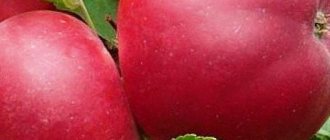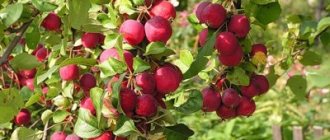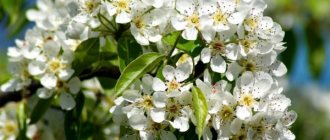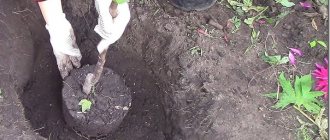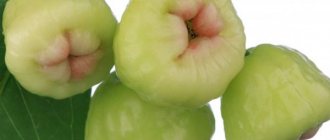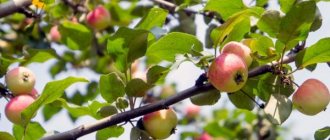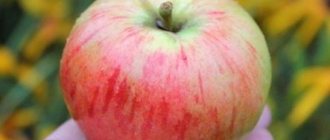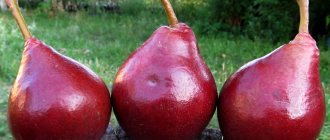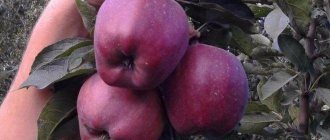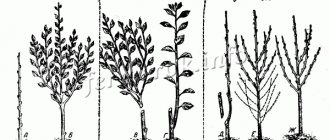The Lobo apple tree is an old variety. Of course, now it can no longer be called one of the best, but many gardeners still keep Lobo on their plots. She has earned popularity through her faithful service for many years, presenting her owners with delicious, beautiful apples.
- 2 Planting a Lobo apple tree
- 3 Features of cultivation and subtleties of care
3.1 Video: young Lobo apple tree with fruits
Characteristic
The characteristics of the Lobo apple tree are typical for a representative of medium-sized trees. Its crown is medium in size, rounded and not thickened. The branches grow parallel to the ground, they are powerful, but very flexible. Flowering is abundant, long lasting, the inflorescences are white and pink.
The fruits are round-conical, large, crimson almost over the entire area. The thin skin is slightly bluish, with white dots visible. The fruits are very beautiful and retain their presentation for a long time. The photo shown is a Lobo apple, just taken from the tree.
Tasting assessment
Lobo apples differ not only in external characteristics, but also in taste. The pulp is quite dense, but at the same time tender and juicy. The taste is more sweet, the taste is very interesting, caramel. Light sourness only adds charm.
Fruits of the Lobo apple tree.
The composition of the fruit is also noteworthy. They contain many useful substances, including ascorbic acid, but also a lot of sugars. Apples are used to make sweets and are loved fresh. This is because the organoleptic rating of the fruit 4.8 points out of 5 is simply a wonderful result.
Pollinators
The Lobo variety is not self-pollinating and requires the company of pollinators. There are several varieties of apple trees that are perfect for this:
- Green May;
- Martovskoe;
- Spartacus;
- Mac;
- Orlik.
However, some others will also work. It is important that the apple trees bloom at the same time as the Lobo. The distance from neighboring apple trees should be no more than 50 meters.
Crown height and diameter
The Lobo apple tree is medium-sized, but grows quite intensively in the first years. To keep the crown round, pruning will be needed. Due to the fact that the apple tree has sparse branches, the fruits ripen well, because they fully receive sunlight. The leaves are ovoid, large, wrinkled, matte.
Productivity
It is worth noting the productivity of this variety. It is high. Fruit ripening occurs annually, without rest stops and cyclicality. The tree is resistant to cold, so it bears fruit in almost any climatic conditions. The apple tree has a tendency to rapidly regenerate, so it is not afraid of diseases and harsh winters.
A tangible advantage is that the fruits are removed from Lobo almost simultaneously and the harvest is not lost. But the harvest is so abundant that gardeners are advised to even support small branches so that they do not break off.
Beginning of fruiting
The Lobo apple variety is quite fast-growing, so the first fruits can be harvested within three years after planting. You will have to wait six years to get vaccinated, but it is definitely worth it.
Lobo apple harvest.
Ripening time
Lobo apples, like all winter apples, are most delicious at the first frost. However, you need to remove them a little earlier to prepare them for storage. Therefore, depending on the growing region, harvesting occurs at the end of September or beginning of October. The shelf life of apples is about three months.
Winter hardiness
The variety has enviable winter hardiness. Lobo doesn't need cover in almost any region. And even if it partially freezes, it is easily and quickly restored.
But you should know that winter hardiness of the variety is possible only under healthy tree conditions. But with immunity it’s a little more complicated, it’s not that high. Therefore, it will be necessary to regularly carry out preventive measures to prevent the emergence of diseases.
Description of the Lobo apple tree
The Lobo apple tree belongs to the medium-sized species and grows up to 4 meters in height. It has a round, medium-spreading, non-thickened crown. The leaves are large, oblong-oval, ribbed. The branches of the apple tree are strong, slightly curved and flexible, growing horizontally to the ground. The tree blooms with large white flowers of medium intensity.
The fruits of the Lobo apple tree are large (150–200 g), flattened-round or slightly conical in shape. By the time they ripen, they become speckled crimson-red, with a waxy coating. The pulp is dense, juicy, sweet, with a subtle caramel aroma. The skin of the fruit is thin, tender, smooth.
Grown on vigorous, dwarf and semi-dwarf rootstocks. The variety is adapted for cultivation in the Central Black Earth region. It is widely used in the USA, Canada, and Eastern European countries.
Features of planting and care
Planting and caring for a Lobo apple tree is an important condition for the health of the plant. The Lobo variety is not picky and is planted in the same way as many other apple trees.
Here's what you need to do:
- the hole for planting must be prepared in advance and mineral fertilizers added to it;
- Place a seedling in the hole in the center and sprinkle with soil;
- trample a little and water.
Saplings of the Lobo apple tree variety.
Can be planted in autumn and spring. In the second planting option, you will need to add some nitrogen fertilizers. Lobo apple tree seedlings need to be tied up.
Crown formation and anti-aging pruning
The Lobo variety easily tolerates pruning and is formed. But it will be necessary to give the tree the desired shape gradually, from the first years of life. Pruning, including anti-aging, will help keep the apple tree healthy.
Disease resistance
The Lobo variety does not have high immunity. This is a significant minus. Scab and powdery mildew often occur on apple trees. That is why it is necessary to carefully monitor the health of the tree, spraying and pruning in a timely manner.
It is very important to protect the young seedling from rodents, which can cause significant harm. To do this, you need to wrap the trunk or coat it with a mixture that repels them.
Stunted apple tree growth
The Loko apple tree continues to grow for the first 3-4 years. But growth delays occur. There are several reasons for this:
- wrong landing site. The proximity of groundwater negatively affects tree growth;
- poor quality soil. It is important to properly prepare the planting hole and add the necessary components;
- bad seedling, sick or damaged.
Lobo apple tree.
All these criteria can easily be eliminated if all the rules of agricultural technology are correctly followed.
Diseases and pests of the variety
Powdery mildew is a fungal disease that most often affects Lobo apple trees. The fungus actively reproduces in conditions of high humidity at temperatures from +20°C to +25°C. It appears as a white powdery coating on leaves, shoots and flower ovaries. Leads to the death of leaf blades and branches. Fruits infected with the disease have a mark in the form of a circular network of fungal spores.
Measures to combat powdery mildew:
- Loosening the soil around the trunk to prevent the spread of mold.
- Collection of fallen leaves and fruits, their further burning.
- Treatment with copper sulfate 1%. A solution is prepared from 100 g of copper sulfate per 10 liters of water. Irrigation is carried out 3 times, with an interval of 7 days.
- Treatment with a soap solution and soda for 3 days, repeating the procedure after 7 days. The solution is prepared from 100 g of liquid soap and 60 g of baking soda, diluted in 10 liters of warm water.
Scab is a disease that affects the fruits, shoots and leaves of the plant. The disease can be noticed by the presence of brown dry spots on the leaves and fruits. Spores can overwinter in the soil, on old leaves and fruits, as well as in cracks in tree bark.
Measures to combat scab:
- Cleaning up fallen leaves and fruits.
- Spraying with 3% Bordeaux mixture after the leaves fall. The solution is prepared from 300 g of Bordeaux mixture and 10 liters of water.
The apple tree is also susceptible to aphid , which damages the entire deciduous part of the tree. Aphids feed on the sap of the leaves and flowers of the plant. You can notice the presence of an insect on a plant by curled leaves on which a whitish coating forms. Ants appear on a crop that has been attacked by aphids; they are attracted by the sweet juice secreted by the pest.
Fighting aphids:
- Manual harvesting of damaged leaves.
- Spraying with a soap solution of 300 g per 10 liters of water.
- Use of the drug "Karbofos", 90 g per 10 liters of water.
To avoid the occurrence of pests and diseases, it is necessary to carry out the following preventive measures annually:
- Sanitary pruning of branches in spring and autumn.
- Timely removal of leaves and fallen fruits.
- Removing weeds in summer.
- Spraying with a solution of copper sulfate 100 g per 10 liters of water, before flowering and after flowering.
Did you know? Oddly enough, 25% of the volume of an apple is... air. It is for this reason that apples do not drown in water.
Types of rootstocks
Any of the winter-hardy rootstocks is suitable for growing the Lobo variety. Here is a short description of each of them.
Dwarf
On a dwarf rootstock, the tree will not grow more than two meters, but the crown will be rounded. The growth rate will be slightly slower compared to a normal tree.
Semi-dwarf
Semi-dwarfs reach a height of three meters. They bear fruit three years after planting; the taste and quality of the fruit is not reflected in any way by the size of the rootstock.
Columnar
The lobo is also shaped like a column. The apple tree grows up to two meters and has no branches. Then the fruits form in large inflorescences on the ringlets.
Lobo apple tree is a columnar variety.
Stlantsevy
In this form, the variety is most often grown in cold climates. This makes it easier to cover and care for the apple tree. Fruiting is the same as that of an ordinary tree.
Video
You can get acquainted with the opinions of specialists and experienced gardeners about the Lobo variety, get advice on pruning an apple tree and evaluate its productivity by watching the following videos:\
About the author:
Found a mistake? Select the text with the mouse and click:
Ctrl + Enter
Do you know that:
Convenient Android applications have been developed to help gardeners and gardeners. First of all, these are sowing (lunar, flower, etc.) calendars, thematic magazines, and collections of useful tips. With their help, you can choose a day favorable for planting each type of plant, determine the timing of their ripening and harvest on time.
Growing in regions
In areas where climate conditions are loyal and calm, Lobo is often grown. This applies to regions with nutritious black soil. Therefore, the apple tree is widespread in Belarus, Ukraine, the Moscow region and the Volga region. In the Leningrad region, the soil is quite poor, so cultivation is possible only with proper care.
But in cold regions, in Siberia or the Urals, apple trees are most often grown in stale form. Although the tree is winter-hardy, its immunity is not the highest, so it needs shelter.
Reviews
Olga: “I’m just a beginner gardener, and this is my first apple tree. The good news is that she is not picky and I can deal with her. This year we ate delicious first apples.”
Victor: “We grow many different varieties of apple trees in Ukraine, but I chose this one. Satisfied. It can withstand even harsh winters with dignity. I take care of it so that it doesn’t get sick, I spray it and trim it in the spring.”
Svetlana Vasilievna: “And I really like to leave some apples on the tree until frost. They are then the most delicious, in my opinion.”
